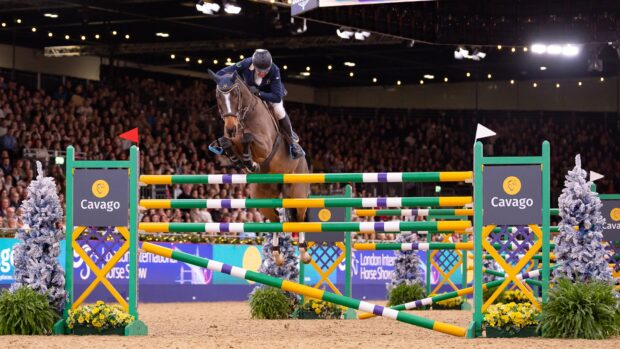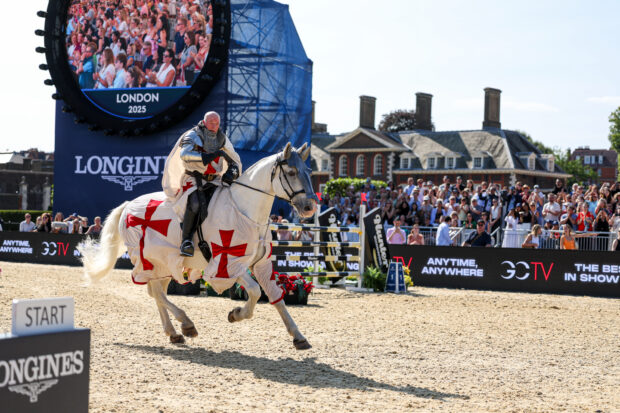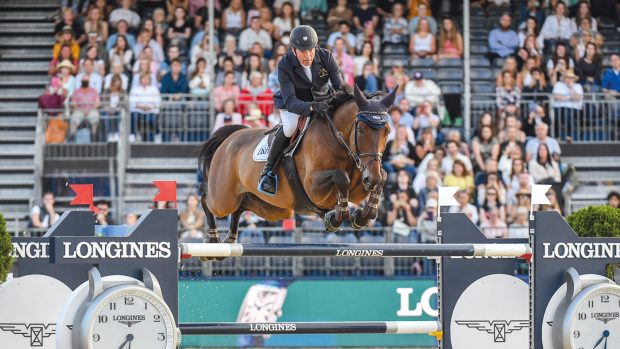By Adella Lithman
Tucked away under John Whitaker’s drinks’ bar in his old stone Yorkshire farmhouse is a box with a chip of bone in it, and precious snippets of a mane and tail. They are mementos of Ryan’s Son, the bay horse John’s father, Donald, thought was sheer talent and which John, at first sight, considered a cart horse with big feet, big head, too much white on him, a ewe neck and standing barely 16hh.
But in one 24-hour period, Ryan’s Son was to become the crucial factor as to whether John Whitaker remained a milkman delivering 40 gallons in pint and half-pint bottles every morning for the family’s dairy, or whether he would develop into the sportsman he is today, holder of an MBE, one of the world’s greatest show jumpers, with a sackful of medals, and a bag ready to pack for the 1996 Olympics.
Ryan’s Son had a mere 50p on his BSJA card when he was given to John by Malcolm Barr, who would later become his father-in-law. The horse and teenager clicked immediately, becoming the team to beat at local shows around Huddersfield.Then, more ambitiously, the six-year-old Ryan’s Son, and John’s other horse, Singing Wind, were entered at the Great Yorkshire Show, which posed the stiffest test in their careers. John, at 17, disliked the result, which totalled 20 humiliating faults in front of crowds that included former schoolmates, friends and family.
“I was out of my depth,” says John, “and I told my father on the way home in the lorry that I did not want to go back to the show the next morning.”
Donald Whitaker turned a deaf ear to his son’s plea, and the reluctant John and overly keen Ryan’s Son returned to the show the next day, to come first in their class, trouncing the teenager’s heroes David Broome and Harvey Smith.”It was unbelievable,” says John. “I had looked up to those two all my life, particularly Harvey Smith because he was a Yorkshireman. I had tried to copy what they had done and had beaten them. Just one day changes everything in your life. From that point on, I never looked back. Ryan put me on the map, and if it were not for him, I would still be a milkman.”
The bay gelding, who resembled a Clydesdale crossed with a Thoroughbred, was on the campaign trail for 14 years, always in the same bit with which he arrived as a four-year-old – a rusty looking twisted snaffle with long cheek pieces, one of which was broken.
He was the biggest money-winner on the circuit for 10 years, an Olympic team silver medallist, and had a posse of fans who adored him for his endearing habit of bucking after the last fence.
“He was showing off,” says John. “He knew he had finished by the applause and by feeling me switch off the pressure. He said: ‘that’s it, I have done it’, and bucked. It was off-putting, though, if the audience clapped after a difficult combination in the middle of a round, because he bucked then too, which would put you wrong for the next fence.”
Ryan¨s only fault was his tendency to hot up, and John Whitaker, who is affectionately known as “Spot” to the senior show jumping fraternity, heeded his father’s words about not changing tack or tactics, but simply to turn Ryan out in the field between shows. It is advice that Spot has followed since with other horses.
“Like the very best of them, Ryan had character, but he was a ‘nice person’ too. His greatest asset was his consistency. You could guarantee jumping a clear round.”
John, 41, who is married with three children, took the odd-looking little Olympian horse around the globe, harvesting silver in the European Championships, and bronze in the World Championships.
But the rider’s most treasured moment was capturing the prestigious and elusive King George V Cup when Ryan was 17, after the trophy had been snatched from their grasp so many times before. Spot was last to go in the jump off, and the man who is not renowned for his exuberance, but knowing he had won after touching down over the last, flung his hat high in the air.Despite a triumph in the Derby, Hickstead was their bogey ground. There, in the early days, Ryan put in a series of uncharacteristic stops, and John, exasperated, snatched a branch from a hedge and chastised him for the first and only time.
Hickstead was, in fact, the scene of Ryan’s terrible and inconceivable ending. The gelding had a tendency to bank a wide fence by dropping his hind legs in the middle and snatching them up again. In 1987 the 18-year-old Ryan banked the parallel white oxer, failed to snatch his legs in time, and tipped up. It did not seem a bad fall, and horse and rider walked out of the ring.
But three hours later, in a private stable of the master of Hickstead, Douglas Bunn, and with the vet in attendance, Ryan’s Son collapsed suddenly and died, probably from an internal haemorrhage.
John and his wife Clare, were there, so too was his mother Enid, who had taught John to ride, and father Donald. The family were shocked and in tears.
They covered the gelding with a rug and took snippets of his mane and tail, remembering they still had the tiny chip of bone removed years before in an operation on his pedal bone. The journey back to Yorkshire, without Ryan’s Son, who had transformed John Whitaker’s life, was the longest, saddest and most silent they ever made.
First published in Horse & Hound magazine.



